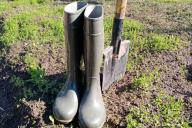Many people love the aromatic and healthy root vegetable celery, but when trying to grow this vegetable in their garden, they encounter the fact that the root vegetable turns out small.
The reason lies in the mistakes that summer residents make. This article lists the 3 most common ones.
TOP 3 mistakes when growing celery root
3rd place: wrong variety selected
Celery is a plant with a long growing season. Sometimes it is up to 200 days. Such celery can be grown only in the southern regions. Attempts to breed early varieties led to the fact that with the reduction of the growing season, the size of the root crop also decreased. There are varieties whose root crop weighs 200-300 g. As a rule, they are early ripening, suitable for cultivation, for example, in Siberia.
If you want to grow large celery, weighing at least 800–1000 g, you need to select large-fruited varieties with medium ripening periods.
2nd place: leaf trimming
From time to time, various sources advise that the leaves of root celery should be cut off, leaving only 5-6 of the youngest ones. But this is a direct path to crop failure.

It is the leaves that are the guarantee that the root crop will grow large and tasty. Nutrients are processed and accumulated in the green mass, which, as the leaf dies, flow into the root, which leads to its growth.
Yes, you can remove fallen and yellowed leaves, as they have already given up all their nutrition. But you can't cut off green ones.
1st place: incorrectly organized feeding
The plant needs 3 additional feedings. The first is carried out 10 days after transplanting into open ground. This should be nitrogen feeding. But it is better to reduce the dosage, since with excess nitrogen, celery begins to fatten - the leaves grow actively, but not the root crop. Just reduce the manufacturer's recommended dose by about half.
The second feeding is carried out at the beginning of July. You should choose a fertilizer where nitrogen, phosphorus and potassium are contained in equal quantities.
The third feeding should be done in mid-August. It should be phosphorus-potassium. Nitrogen is not needed during this period. But phosphorus and potassium will help ensure that nutrients from the leaves flow more actively into the root crop. As a result, celery will grow not only large, but also very tasty and aromatic.
Try to take these three subtleties into account when growing root celery. Most likely, you will get an excellent harvest in the first year.








